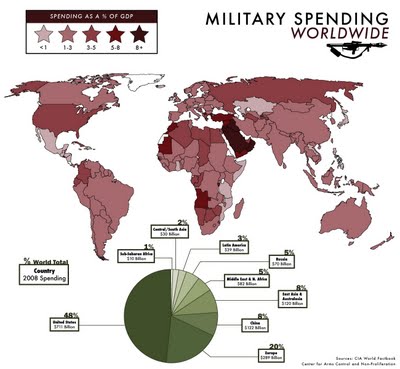Jessica H.S. sent in a link to this map showing global military spending as a % of GDP as as a % of total world military spending (much larger version available here):

I knew the U.S. spent a ginormous total amount on the military, but I didn’t know we account for right at half of all military spending. And I would have thought China would have more than 8%.
Commenter George has a good point that I really should have thought of:
Saying we account for half of all military spending is misleading. It costs a great deal more to construct military equipment in the U.S. so, of course we spend a larger number of dollars than China would. In China a submarine costs many fewer dollars to build. Of these illustrations the percent of GDP is by far the most informative.
Thanks for pointing that out!

Comments 15
Nicole — August 5, 2009
I always hear China always under reports their military spending which is why it is always so small. Dunno how true it is.
chuk — August 5, 2009
Canada is missing from the pie chart, hehe. Maybe we're included under Latin America.
wastelandamerica — August 5, 2009
Can you post a larger pic? Can't see.
Gwen Sharp, PhD — August 6, 2009
I can't get a larger image up--it's gets blurry and weird. If you click on the link listed above the map, it gives you a much larger version where you can read everything easier.
Sandra — August 6, 2009
Imagine if all this money would be used for charity...or to enforce the educational and health care system.
I am rather surprised to see a color on Iceland, as there isn't any Icelandic army.
Titanis walleri — August 6, 2009
"I always hear China always under reports their military spending which is why it is always so small. Dunno how true it is."
I wouldn't be surprised. iirc, they were (are?) massively underreporting how many fish they were catching...
opminded — August 6, 2009
Recall that the US has been the umbrella defense for much of Europe and Japan for more than half a century so rightly a portion of that spending should be attributed to other countries as well.
jesse — August 6, 2009
http://en.wikipedia.org/wiki/List_of_countries_without_armed_forces
George — August 6, 2009
Saying we account for half of all military spending is misleading. It costs a great deal more to construct military equipment in the U.S. so, of course we spend a larger number of dollars than China would. In China a submarine costs many fewer dollars to build. Of these illustrations the percent of GDP is by far the most informative.
Stian Haklev — August 6, 2009
I think the biggest difference in military spending between China and the US would be salaries and costs of housing and feeding the armed men and women. I don't think equipment would wary that much - buying a cell phone in China is roughly the same cost as it is in the US, and there is a worldwide market for armaments, I would be surprised if the prices differed radically.
EKSwitaj — August 6, 2009
Why would the Chinese government under-report military spending when they want to be viewed as a world power?
indregard — August 7, 2009
George's addendum does not make that much sense. In the litterature regarding this it is perfectly normal to use both a PPP (purchasing power parity) and straight nominal-dollars figure, because military costs do not vary in the way George suggests. While he would be (more) right if he was discussing salaries, food and so on, construction of weaponry is a largely internationalised business. The only reason a submarine would be cheaper in China than the US would be if all the work on a submarine was performed domestically. Obviously, it isn't. I do not know much about submarines, but steel, computers, tubes, paint (?) and everything else you need for a submarine would be bought on the world market, even if you decided to assemble the sub at home.
George's statement does not make any more sense than saying airplanes would be cheaper to buy in China than in the US. No, the same airplane will cost the same amount of dollars. Otherwise, all US airlines would buy their airplanes in China. It's the same thing with most stuff that is huge and at the technological cutting edge.
Therefore, military spending in nominal dollars do tell a lot. But the cost of human resources will vary. Therefore: use both figures. But for most purposes it is more instructive to use a proper PPP dollar instead of "fraction of GDP". While GDP correlates with PPP, it isn't a straightforward linearity, and some of the world's largest military spenders (middle-easters) are the outliers.
Interactive Global GDP Graph » Sociological Images — August 29, 2009
[...] posts: military spending as a % of GDP, map of global use of electric lights after dark, carbon dioxide emissions per [...]